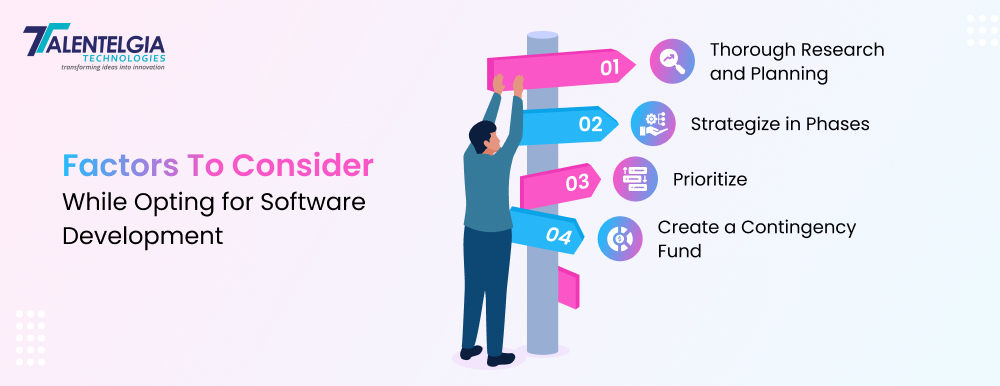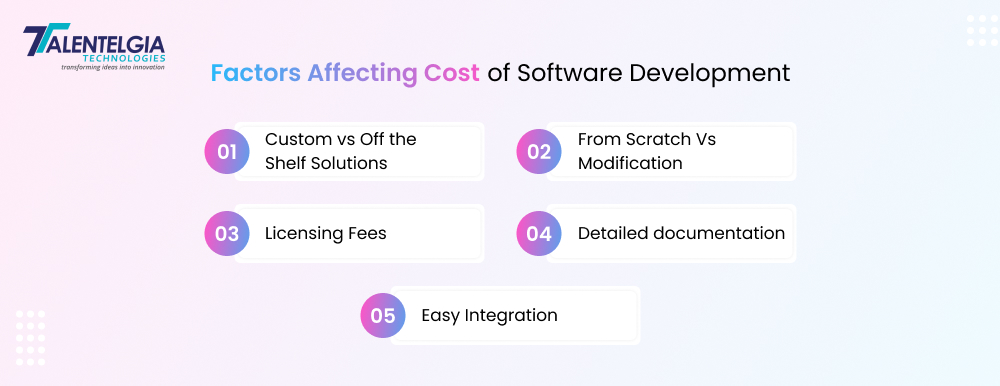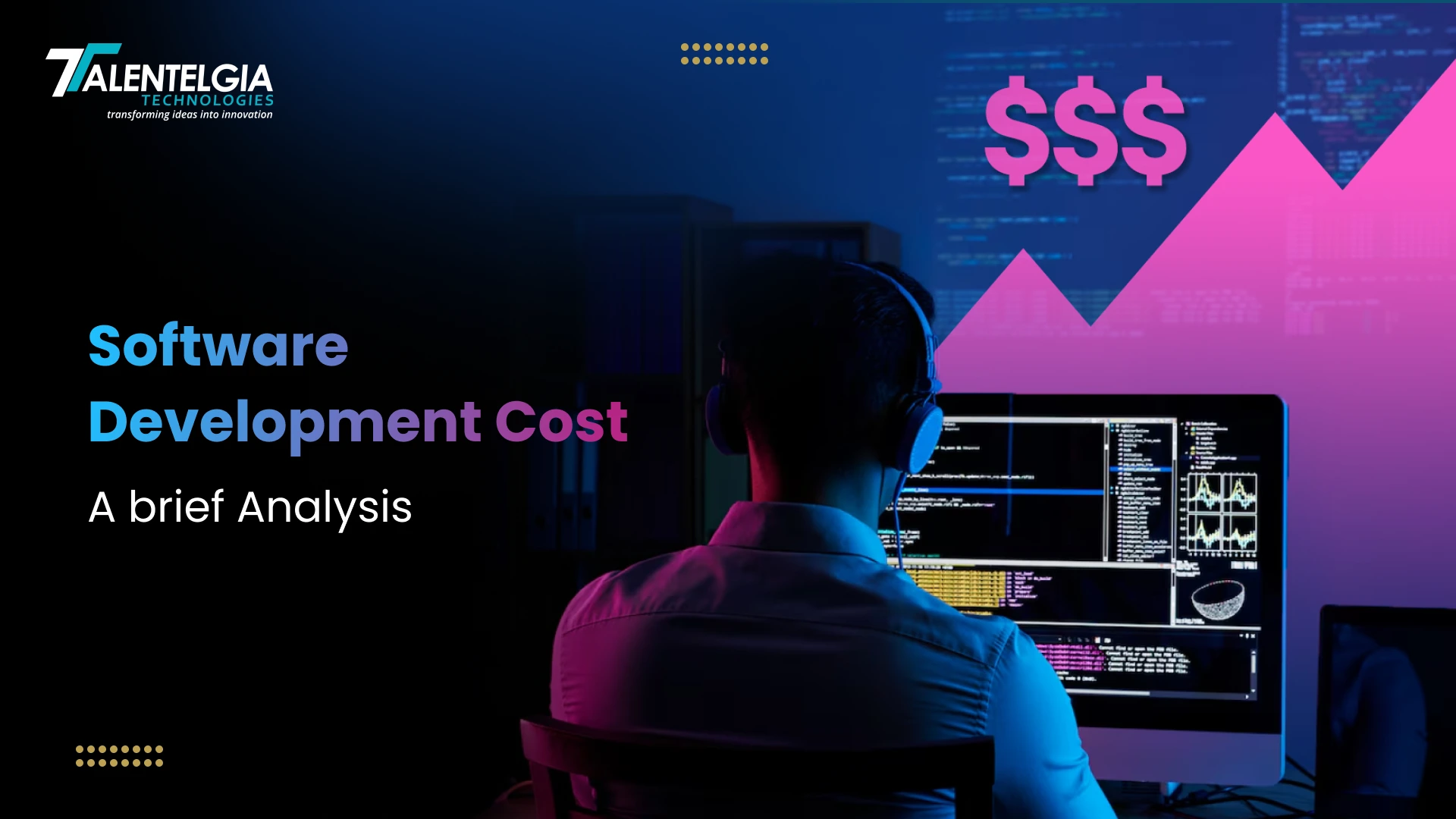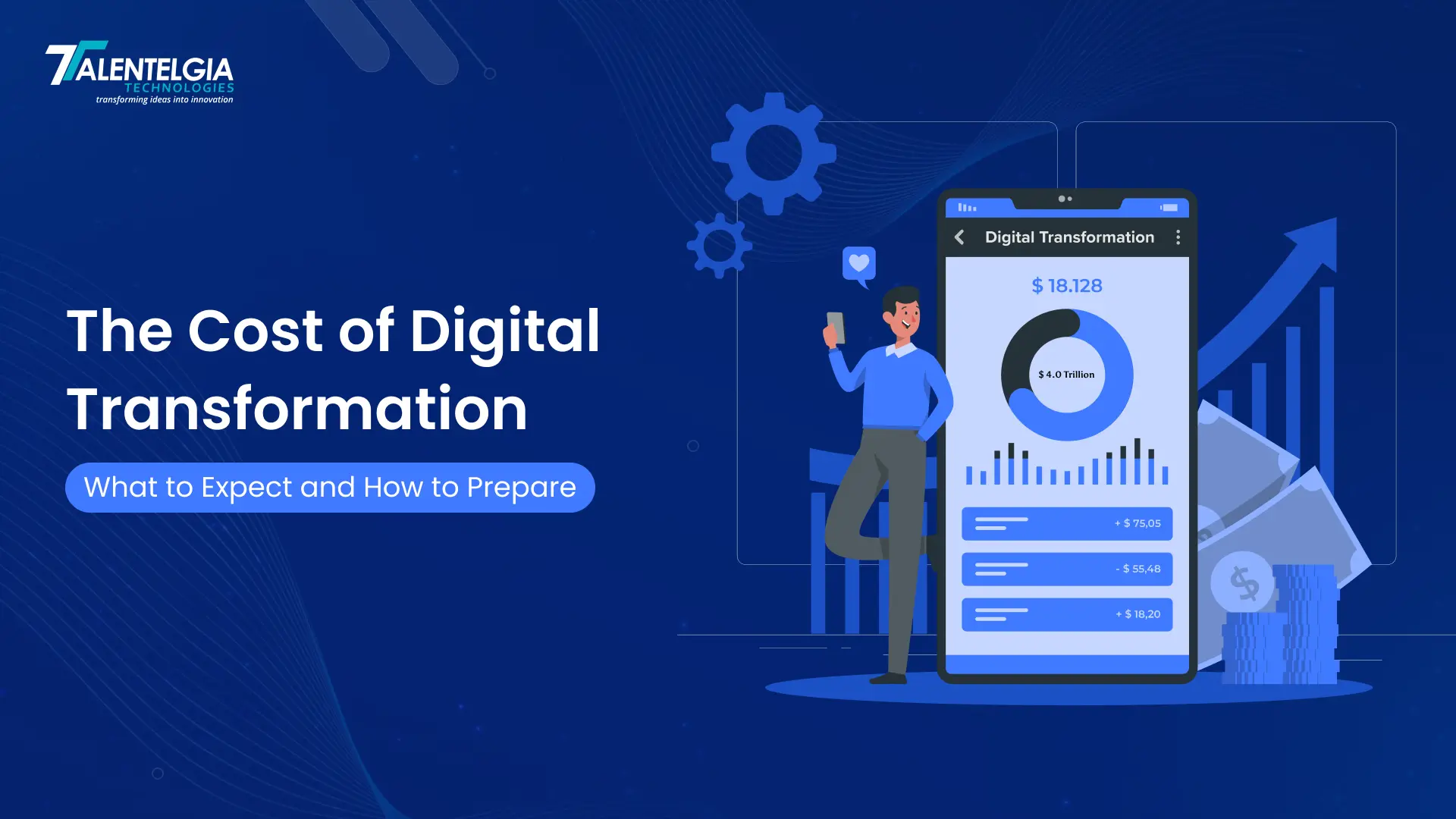Software development cost is the overall expense incurred by a company in the development process. This can include developer fees, tools, licensing, and maintenance.
However, it is worth noting that the cost of developing software can be significantly different in nature, depending on the project’s complexity and scale. All these factors determine the overall expense related to the type of software being developed, the technology stack, and the timeline. You can expect to invest around $50,000 to $250,000. However, if you need a detailed guide on the same, we have covered everything in this blog.
The type of software, technology stack, and timeline directly determine the overall development expense.
This blog will help you understand the nuances of the overall cost incurred as well as define the project scope. But first, let’s understand the factors you must consider before starting your software development. Let’s dive right in!
Factors To Consider While Opting for Software Development

1. Thorough Research and Planning
A prerequisite to launching a software development project is extensive research. Knowing the target market, user needs, and the challenges or obstacles can make all the difference between project success and failure. For instance, a company developing a fitness application might determine, that its success hinges on wearable device integration compatibility. It will ensure that the project scope, milestones, and estimates are made according to expectations.
2. Strategise in Phases
Breaking up a project into smaller, more manageable parts is a strategic approach that helps in cost management. Each of these phases must have very well-defined deliverables, timelines, and budgets so teams can work on specific increments toward achieving defined goals. Monitoring the progress of the work becomes easier by breaking it down into phases, thus allowing earlier identification of problems. This ensures that the available resources is appropriately utilized in response to direct priorities, maximizing both time and budget.
For instance, an e-commerce website can be developed in different phases. The first phase may concentrate on designing a beautiful and user-friendly home page to lay a proper foundation. Once that is achieved, the second phase would involve creating the payment gateway, allowing transactions to be processed without interruptions. This ensures that core features are built in phases, reducing the chances of resource mismanagement.
3. Prioritise
Feature and functionality prioritization is critical in software development, as it makes the process more streamlined and ensures task prioritization. All features are not equal, and focusing on the most critical ones at the beginning can save time and resources. The team can then allocate their efforts toward functionalities that relate directly to the core use of the application. This process also enables better planning since it does not overwhelm a project with features that have no immediate use.
For instance, while developing a food delivery application, core functionalities like placing an order, or GPS tracking are important. On the other hand, the development of features about the personal profiles of the user will be a secondary functionality. By prioritizing the important functionalities, the team can release a beta version of the app to check the market response. Once the essential features are in place and tested, functionalities like advanced search options can be added in subsequent updates.
4. Create a Contingency Fund
Creating a contingency fund is important for budgeting, as unforeseen issues can arise at any stage of the project. By setting aside a portion of the total budget—typically 10% to 15%—you provide the team with financial flexibility. Such changes improve the project scope, unforeseen technical issues, or even regulatory conditions that have not been factored in before. This avoids delays and ensures timely task completion even if difficulties arise.
Consider developing a healthcare app designed to manage patients’ data. If any regulatory compliance arises during development, further implementation of security measures has to be done to comply with new laws. If changes were not initially budgeted, the project would be pushed back. With a contingency fund, the development team can adjust to these challenges without letting the app’s timeline be affected. This financial buffer is a comfort and a surety that the project stays within scope at all times.
Now that we have covered the prerequisites of software development, let’s get into factors that affect the cost of software development.
Factors Affecting the Cost of Software Development
Software implementation projects come in several forms, each requiring unique team composition and varying amounts of development effort. Between web and mobile development, the nature of the project tends to greatly influence costs. Below, we look into some of the most common project types and their factors of cost.

Custom vs Off Shelf Solutions
At a broad level, software solutions can be classified as either custom-built or off-the-shelf. Off-the-shelf solutions generally have a one-time purchasing fee and low initial costs. However, they often fall short in terms of customization and alignment with specific business needs. This limitation drives many businesses to invest in custom software development to ensure greater operational efficiency and higher ROI.
Custom software development is expensive at the onset but offers a bespoke approach that takes into account specific business needs. This requires deep analysis by the development team to design a solution that integrates the right mix of technologies and tools.
A typical in-house custom software development team can encompass:
- Business analysts
- UX/UI designers
- Product/Project managers
- Developers
- Quality assurance specialists
Each person assumes an important role in particular stages of development. This implies that team structure is among the most critical cost drivers on software projects.
From Scratch Vs Modification
Improving existing software includes improvement of specific components, like updating the user interface or implementing features to meet user demands. Unlike developing a brand-new product, these modifications usually involve a smaller scope of work, making them more cost-effective.
On the other hand, developing from scratch means you have to write a completely new solution with extensive planning, design, and development efforts. It comes out to be more cost-intensive because of the added development hours and resources required.
Licensing Fees
Another critical cost is licensing agreements between developers and companies. Licensing agreements enable developers to monetize their work while ensuring that end users get secure and reliable software. Licensing fees compensate developers for the time, effort, and resources invested in their work, allowing businesses to access robust services.
Documentation
Documentation is the main blueprint of software development since it holds all essential details such as coding processes, system architecture, and maintenance guidelines. Thus, if proper documentation isn’t maintained, it creates significant challenges for the update.
For instance, one company might need to change its software after years since its installation. If the original development process is not documented, then new developers might take too much time to reverse-engineer the code, which may cause delays and extra costs. So comprehensive documentation prevents such inefficiency and provides clear guidelines that help in smooth transitions.
Integration
Modern applications are often built on Cloud or SaaS platforms, which have recurring hosting fees that need to be added to the budget. The monthly costs vary from $50 to $1,000 depending on the service provider and the type of cloud hosting. For SaaS platforms, hosting expenses can go up to $10,000.
Further, going for cloud hosting also requires hiring experts who handle and maintain the infrastructure. Including these costs in the budget ensures that the organization selects the most appropriate solution for hosting while avoiding the unwanted burden of financial strain.
Remember, software development is a combination of factors rather than being a sole unit. The software complexity, and team structure of UX/UI designers, play an important role in shaping the development costs. For instance, custom-built applications are more expensive and often demand a more tailored approach. This is especially true for specialized platforms such as mobile and web apps.
The following table gives a cost breakdown to illustrate different app types and how these factors apply across different platforms. As you can see, mobile applications that demand more features are eCommerce platforms and booking apps. They are likely to ask for higher development hours and more resources, which makes costs go higher. Likewise, the platform chosen will have its set of considerations such as hosting, expert infrastructure management, and licensing fees. This breakdown will help you understand how the above factors translate into real-life budgetary requirements in different software development projects.
| App Type | Platform | Hours | Cost |
|---|---|---|---|
| Basic Marketplace App | Web | 1168 | $52,560 |
| iOS | 862 | $38,790 | |
| Android | 847 | $38,115 | |
| Basic eCommerce App | Web | 1200 | $54,000 |
| iOS | 1550 | $69,750 | |
| Android | 1500 | $67,500 | |
| App like Spotify | Web | 968 | $43,560 |
| iOS | 868 | $39,060 | |
| Android | 800 | $36,000 | |
| Booking App like Airbnb | Web | 1350 | $60,750 |
Conclusion
Navigating the complexities of the cost of software development calls for a strategic approach and an eye for detail. Beyond technical aspects, understanding the financial landscape is crucial to ensuring that projects stay on track and deliver maximum value. The choice you make—whether opting for a custom solution or working within an existing framework—can have impact on the outcome. This is true not just in terms of development but in the long-term operational success of the project.
The bottom line is that great software development is not merely writing code. It’s making smart, thoughtful decisions right from the start. When you proactively manage your budget, identify hidden costs, and address potential roadblocks, you have all the ingredients for a smooth workflow. This also ensures a better return on investment. With a solid technical and financial background, you bring your software development ideas to fruition seamlessly.


 Healthcare App Development Services
Healthcare App Development Services
 Real Estate Web Development Services
Real Estate Web Development Services
 E-Commerce App Development Services
E-Commerce App Development Services E-Commerce Web Development Services
E-Commerce Web Development Services Blockchain E-commerce Development Company
Blockchain E-commerce Development Company
 Fintech App Development Services
Fintech App Development Services Fintech Web Development
Fintech Web Development Blockchain Fintech Development Company
Blockchain Fintech Development Company
 E-Learning App Development Services
E-Learning App Development Services
 Restaurant App Development Company
Restaurant App Development Company
 Mobile Game Development Company
Mobile Game Development Company
 Travel App Development Company
Travel App Development Company
 Automotive Web Design
Automotive Web Design
 AI Traffic Management System
AI Traffic Management System
 AI Inventory Management Software
AI Inventory Management Software
 AI Software Development
AI Software Development  AI Development Company
AI Development Company  AI App Development Services
AI App Development Services  ChatGPT integration services
ChatGPT integration services  AI Integration Services
AI Integration Services  Generative AI Development Services
Generative AI Development Services  Natural Language Processing Company
Natural Language Processing Company Machine Learning Development
Machine Learning Development  Machine learning consulting services
Machine learning consulting services  Blockchain Development
Blockchain Development  Blockchain Software Development
Blockchain Software Development  Smart Contract Development Company
Smart Contract Development Company  NFT Marketplace Development Services
NFT Marketplace Development Services  Asset Tokenization Company
Asset Tokenization Company DeFi Wallet Development Company
DeFi Wallet Development Company Mobile App Development
Mobile App Development  IOS App Development
IOS App Development  Android App Development
Android App Development  Cross-Platform App Development
Cross-Platform App Development  Augmented Reality (AR) App Development
Augmented Reality (AR) App Development  Virtual Reality (VR) App Development
Virtual Reality (VR) App Development  Web App Development
Web App Development  SaaS App Development
SaaS App Development Flutter
Flutter  React Native
React Native  Swift (IOS)
Swift (IOS)  Kotlin (Android)
Kotlin (Android)  Mean Stack Development
Mean Stack Development  AngularJS Development
AngularJS Development  MongoDB Development
MongoDB Development  Nodejs Development
Nodejs Development  Database Development
Database Development Ruby on Rails Development
Ruby on Rails Development Expressjs Development
Expressjs Development  Full Stack Development
Full Stack Development  Web Development Services
Web Development Services  Laravel Development
Laravel Development  LAMP Development
LAMP Development  Custom PHP Development
Custom PHP Development  .Net Development
.Net Development  User Experience Design Services
User Experience Design Services  User Interface Design Services
User Interface Design Services  Automated Testing
Automated Testing  Manual Testing
Manual Testing  Digital Marketing Services
Digital Marketing Services 
 Ride-Sharing And Taxi Services
Ride-Sharing And Taxi Services Food Delivery Services
Food Delivery Services Grocery Delivery Services
Grocery Delivery Services Transportation And Logistics
Transportation And Logistics Car Wash App
Car Wash App Home Services App
Home Services App ERP Development Services
ERP Development Services CMS Development Services
CMS Development Services LMS Development
LMS Development CRM Development
CRM Development DevOps Development Services
DevOps Development Services AI Business Solutions
AI Business Solutions AI Cloud Solutions
AI Cloud Solutions AI Chatbot Development
AI Chatbot Development API Development
API Development Blockchain Product Development
Blockchain Product Development Cryptocurrency Wallet Development
Cryptocurrency Wallet Development About Talentelgia
About Talentelgia  Our Team
Our Team  Our Culture
Our Culture 
 Healthcare App Development Services
Healthcare App Development Services Real Estate Web Development Services
Real Estate Web Development Services E-Commerce App Development Services
E-Commerce App Development Services E-Commerce Web Development Services
E-Commerce Web Development Services Blockchain E-commerce
Development Company
Blockchain E-commerce
Development Company Fintech App Development Services
Fintech App Development Services Finance Web Development
Finance Web Development Blockchain Fintech
Development Company
Blockchain Fintech
Development Company E-Learning App Development Services
E-Learning App Development Services Restaurant App Development Company
Restaurant App Development Company Mobile Game Development Company
Mobile Game Development Company Travel App Development Company
Travel App Development Company Automotive Web Design
Automotive Web Design AI Traffic Management System
AI Traffic Management System AI Inventory Management Software
AI Inventory Management Software AI Software Development
AI Software Development AI Development Company
AI Development Company ChatGPT integration services
ChatGPT integration services AI Integration Services
AI Integration Services Machine Learning Development
Machine Learning Development Machine learning consulting services
Machine learning consulting services Blockchain Development
Blockchain Development Blockchain Software Development
Blockchain Software Development Smart contract development company
Smart contract development company NFT marketplace development services
NFT marketplace development services IOS App Development
IOS App Development Android App Development
Android App Development Cross-Platform App Development
Cross-Platform App Development Augmented Reality (AR) App
Development
Augmented Reality (AR) App
Development Virtual Reality (VR) App Development
Virtual Reality (VR) App Development Web App Development
Web App Development Flutter
Flutter React
Native
React
Native Swift
(IOS)
Swift
(IOS) Kotlin (Android)
Kotlin (Android) MEAN Stack Development
MEAN Stack Development AngularJS Development
AngularJS Development MongoDB Development
MongoDB Development Nodejs Development
Nodejs Development Database development services
Database development services Ruby on Rails Development services
Ruby on Rails Development services Expressjs Development
Expressjs Development Full Stack Development
Full Stack Development Web Development Services
Web Development Services Laravel Development
Laravel Development LAMP
Development
LAMP
Development Custom PHP Development
Custom PHP Development User Experience Design Services
User Experience Design Services User Interface Design Services
User Interface Design Services Automated Testing
Automated Testing Manual
Testing
Manual
Testing About Talentelgia
About Talentelgia Our Team
Our Team Our Culture
Our Culture

















 Write us on:
Write us on:  Business queries:
Business queries:  HR:
HR: 




